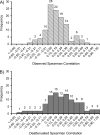Validity of adolescent diet recall 48 years later
- PMID: 19923106
- PMCID: PMC2800269
- DOI: 10.1093/aje/kwp299
Validity of adolescent diet recall 48 years later
Abstract
Few studies have evaluated the validity of adolescent diet recall after many decades. Between 1943 and 1970, yearly diet records were completed by parents of adolescents participating in an ongoing US study. In 2005-2006, study participants who had been 13-18 years of age when the diet records were collected were asked to complete a food frequency questionnaire regarding their adolescent diet. Food frequency questionnaires and diet records were available for 72 participants. The authors calculated Spearman correlation coefficients between food, food group, and nutrient intakes from the diet records and food frequency questionnaire and deattenuated them to account for the effects of within-person variation measured in the diet records on the association. The median deattenuated correlation for foods was 0.30, ranging from -0.53 for a beef, pork, or lamb sandwich to 0.99 for diet soda. The median deattenuated correlation for food groups was 0.31 (range: -0.48 for breads to 0.70 for hot beverages); for nutrient intakes, it was 0.25 (range: -0.08 for iron to 0.82 for vitamin B(12)). Some dietary factors were reasonably recalled 3-6 decades later. However, this food frequency questionnaire did not validly measure overall adolescent diet when completed by middle-aged and older adults on average 48 years after adolescence.
Figures

Similar articles
-
Validity of maternal recall of preschool diet after 43 years.Am J Epidemiol. 2009 May 1;169(9):1148-57. doi: 10.1093/aje/kwp012. Epub 2009 Mar 24. Am J Epidemiol. 2009. PMID: 19318613 Free PMC article.
-
Relative Validity and Reproducibility of a New 44-Item Diet and Food Frequency Questionnaire Among Adults: Online Assessment.J Med Internet Res. 2018 Jul 5;20(7):e227. doi: 10.2196/jmir.9113. J Med Internet Res. 2018. PMID: 29980502 Free PMC article.
-
Evaluating the Validity of a Food Frequency Questionnaire in Comparison with a 7-Day Dietary Record for Measuring Dietary Intake in a Population of Survivors of Colorectal Cancer.J Acad Nutr Diet. 2020 Feb;120(2):245-257. doi: 10.1016/j.jand.2019.09.008. Epub 2019 Dec 3. J Acad Nutr Diet. 2020. PMID: 31806573
-
Validation of a Food Frequency Questionnaire for Estimating Micronutrient Intakes in an Urban US Sample of Multi-Ethnic Pregnant Women.Matern Child Health J. 2016 Feb;20(2):250-60. doi: 10.1007/s10995-015-1824-9. Matern Child Health J. 2016. PMID: 26511128 Free PMC article.
-
Evaluation of the Validity of a Food Frequency Questionnaire and 24-Hour Dietary Recall to Assess Dietary Iron Intake in Children and Adolescents from the South American Youth/Child Cardiovascular and Environmental Study.J Acad Nutr Diet. 2022 Feb;122(2):384-393. doi: 10.1016/j.jand.2021.07.005. Epub 2021 Aug 24. J Acad Nutr Diet. 2022. PMID: 34463258
Cited by
-
The Chinese Children and Families Cohort Study: The Nutrition, Physical Activity, and Ultraviolet Radiation Data Collection.Nutr Today. 2018 May-Jun;53(3):104-114. doi: 10.1097/NT.0000000000000275. Epub 2018 May 23. Nutr Today. 2018. PMID: 29930434 Free PMC article.
-
A Cohort Study of Adolescent and Midlife Diet and Pancreatic Cancer Risk in the NIH-AARP Diet and Health Study.Am J Epidemiol. 2017 Aug 1;186(3):305-317. doi: 10.1093/aje/kwx036. Am J Epidemiol. 2017. PMID: 28459946 Free PMC article.
-
Bread Consumption and Cancer Risk: Systematic Review and Meta-Analysis of Prospective Cohort Studies.Curr Dev Nutr. 2024 Nov 2;8(12):104501. doi: 10.1016/j.cdnut.2024.104501. eCollection 2024 Dec. Curr Dev Nutr. 2024. PMID: 39668947 Free PMC article. Review.
-
Lifetime leisure music exposure associated with increased frequency of tinnitus.Hear Res. 2017 Apr;347:18-27. doi: 10.1016/j.heares.2016.10.030. Epub 2016 Nov 5. Hear Res. 2017. PMID: 27825859 Free PMC article.
-
Adolescent dairy product and calcium intake in relation to later prostate cancer risk and mortality in the NIH-AARP Diet and Health Study.Cancer Causes Control. 2020 Oct;31(10):891-904. doi: 10.1007/s10552-020-01330-z. Epub 2020 Aug 2. Cancer Causes Control. 2020. PMID: 32743740 Free PMC article.
References
-
- Pike MC, Krailo MD, Henderson BE, et al. ‘Hormonal’ risk factors, ‘breast tissue age’ and the age-incidence of breast cancer. Nature. 1983;303(5920):767–770. - PubMed
-
- Rosner B, Colditz GA, Willett WC. Reproductive risk factors in a prospective study of breast cancer: the Nurses’ Health Study. Am J Epidemiol. 1994;139(8):819–835. - PubMed
-
- Rosner B, Colditz G. Nurses’ Health Study: log-incidence mathematical model of breast cancer incidence. J Natl Cancer Inst. 1996;88(6):359–364. - PubMed
-
- Wolff MS, Collman GW, Barrett JC, et al. Breast cancer and environmental risk factors: epidemiological and experimental findings. Annu Rev Pharmacol Toxicol. 1996;36(1):573–596. - PubMed

